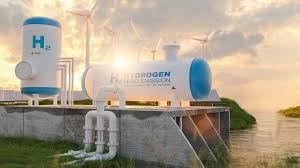India’s Ambition to Become a Green Hydrogen Export Hub (GS Paper 3, Energy)

Context
- India is increasingly focused on harnessing the potential of green hydrogen as a key driver in its energy transition.
- Recently, the Solar Energy Corporation of India Ltd (SECI) signed a Memorandum of Understanding (MoU) with H2Global Stiftung to boost green hydrogen initiatives.
- This collaboration is expected to further India’s goal of becoming a major global exporter of green hydrogen.
Key Points of the MoU
The MoU aims to:
- Enhance knowledge exchange regarding market-based mechanisms for green hydrogen.
- Foster cooperation between India and potential importing countries.
- Facilitate the creation of joint tenders to align with India’s ambition to export green hydrogen and its derivatives globally.
This strategic partnership supports India’s broader energy goals, including achieving energy independence by 2047 and net-zero emissions by 2070, with green hydrogen playing a pivotal role in these efforts.
What is Green Hydrogen?
Hydrogen is the most abundant chemical element in the universe. Green hydrogen refers to hydrogen produced using renewable energy sources like solar, wind, and hydropower. The process of producing green hydrogen, known as electrolysis, splits water (H₂O) into hydrogen (H₂) and oxygen (O₂) using an electric current powered by renewable energy.
In contrast:
- Grey hydrogen is derived from natural gas, producing carbon emissions.
- Blue hydrogen also uses natural gas but captures and stores the emitted CO₂ to reduce environmental impact.
Significance of Green Hydrogen
Green hydrogen is considered a clean, zero-emission energy carrier. It has multiple benefits:
- Zero emissions: No harmful pollutants are released in the production process.
- Energy storage: It can store excess renewable energy and balance the grid.
- Versatile applications: Green hydrogen can be used in transport, industry, and heating sectors.
- Economic potential: The transition to green hydrogen offers vast opportunities for job creation and infrastructure development.
- Climate mitigation: By replacing fossil fuels, green hydrogen contributes significantly to reducing global carbon emissions.
India’s Vision and Progress
India has set ambitious targets, including:
- 5 million metric tons of green hydrogen production by 2030.
- $100 billion investment and 125 GW of new renewable energy capacity needed to achieve this.
- Projected 29 million metric tons of hydrogen demand by 2050.
This growth is driven primarily by industries such as steel, fertilizers, refineries, and transportation. The International Renewable Energy Agency (IRENA) estimates that the green energy sector could generate 42 million jobs by 2050, further emphasizing the economic potential of green hydrogen.
Factors Supporting India’s Export Ambition
Several factors position India to be a global leader in green hydrogen exports:
- Ease of transport: Green hydrogen is easier to transport in liquid form, facilitating long-distance trade.
- Strategic location: India's coastline, especially in states like Odisha, Gujarat, and Maharashtra, supports efficient hydrogen export logistics.
- Port infrastructure: India’s established port facilities are ideal for both domestic and international trade.
These advantages align with India’s broader energy goals and support the growth of global hydrogen supply chains.
Challenges
Despite the advantages, India faces significant hurdles:
- Transportation risks: Hydrogen, especially in gaseous form, is highly flammable, making transportation a safety concern.
- Cost issues: Green hydrogen production remains expensive due to the high cost of renewable energy and electrolysis technology.
- Infrastructure gaps: India must compete globally for hydrogen refueling infrastructure, with only a few hundred hydrogen stations currently in operation worldwide, mainly in Europe, Japan, and South Korea.
Green Hydrogen Initiatives in India
India has implemented several initiatives to advance its green hydrogen goals:
- National Green Hydrogen Mission (NGHM): Launched in 2023, this mission targets the production of 5 million metric tons by 2030, meeting 40% of domestic demand.
- National Hydrogen Energy Mission (NHEM): Part of the broader NHM, this initiative aims to establish India as a global hub for green hydrogen production and export.
- Production-Linked Incentive (PLI) Scheme: This scheme is designed to encourage green hydrogen production and attract investment.
- Public-Private Partnerships (PPP): Indian public sector enterprises such as NTPC and Indian Oil Corporation (IOCL) are leading pilot projects.
India is also collaborating with international organizations to facilitate knowledge transfer and technology adoption in green hydrogen production.
Future Prospects
India’s future in green hydrogen looks promising. To realize its vision, the country needs to:
- Enhance production capacities.
- Build out the necessary infrastructure.
- Create regulatory frameworks and market incentives that encourage adoption.
With these elements in place, India can transition to a low-carbon economy, reduce reliance on fossil fuels, and establish itself as a global leader in the hydrogen economy.
Conclusion
- In conclusion, India’s green hydrogen initiatives hold great potential to transform its energy landscape, reduce emissions, and position the country as a key player in the global hydrogen market.


